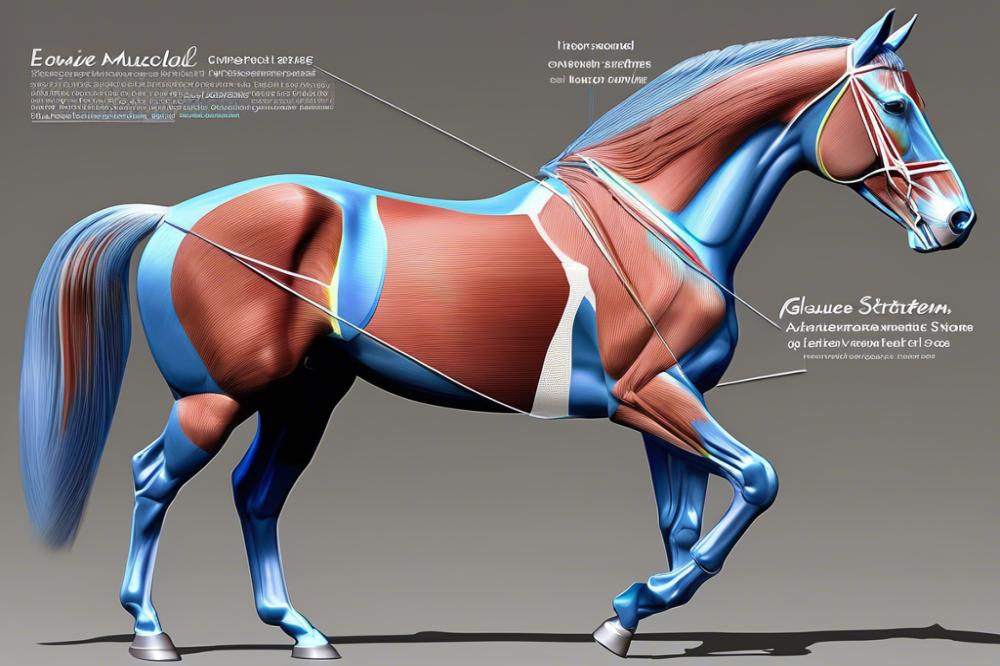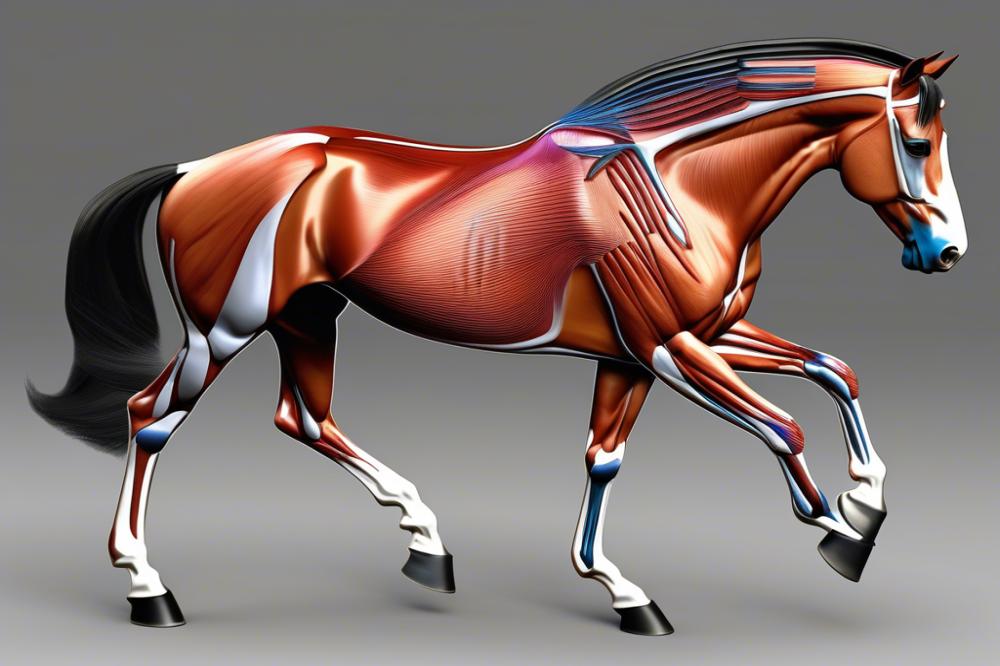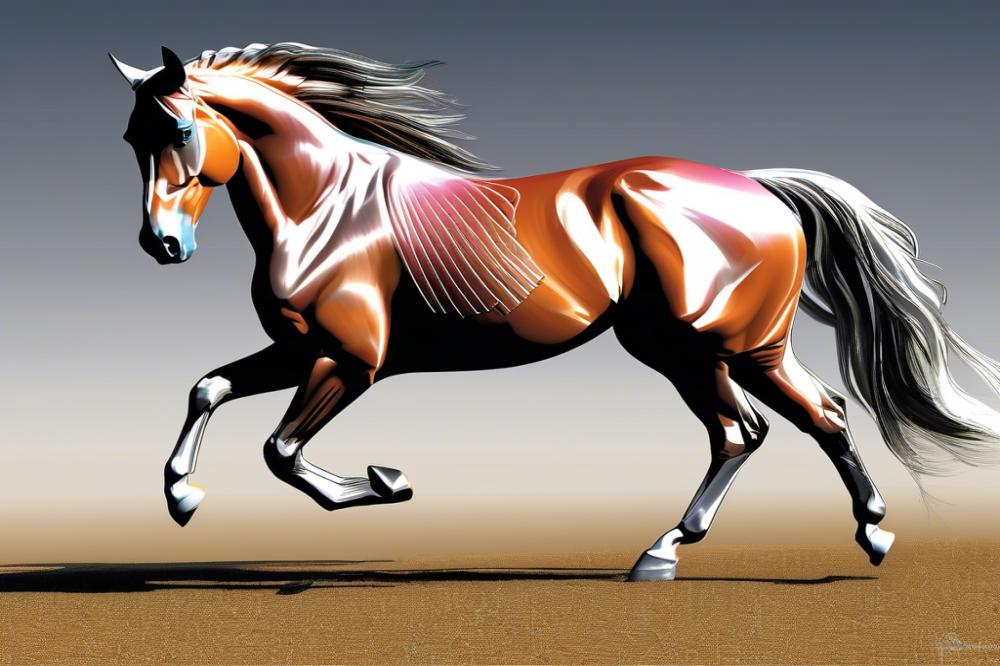Introduction
The equine muscular system plays a crucial role in how horses generate power and speed. These magnificent creatures harness their energy through intricate coordination of muscle contractions and skeletal movement. Each stride embodies a complex symphony of mechanics and physics, exemplifying the remarkable horse biomechanics that allow for rapid acceleration and effortless agility.
Muscles act not only as powerhouses but also as regulators of balance and flexibility. When a horse gallops, the interplay between its muscles and tendons produces explosive speed. Muscles transform stored energy into kinetic energy, propelling the horse forward. Such a process requires precise timing and control, akin to the dance of a well-rehearsed performance.
Anatomy also plays a critical role in a horse’s ability to sprint across varied terrains. The distribution of muscle fibers within the body can influence overall performance. Fast-twitch fibers power quick bursts, while slow-twitch fibers provide endurance. This diversity ensures that each horse possesses distinctive capabilities suited to its environment and purpose.
Understanding these mechanics enriches our appreciation for these extraordinary animals. Observing a racehorse in motion can evoke feelings of awe, reveling in its finely tuned design. The rhythmic cadence of hooves striking the ground mimics a heartbeat, resonating with a harmony that few can forget.
As we delve into the components and functionality of the musculoskeletal system, various factors emerge—speed, strength, and structure. Each element contributes uniquely to the horse’s ability to navigate its world. Without question, the synchronization of muscle, bone, and nerve plays a pivotal role in every leap and gallop.
equine muscular system and horse biomechanics

Description of equine anatomy Related to Muscle Structure
When one looks at a horse, the powerful structure is immediately apparent. Their anatomy is intricately designed for strength and agility. Muscles play a crucial role, forming a dynamic network that supports movement. The skeletal muscles are attached to bones via tendons, allowing for precise control over motion. Each muscle group works in harmony, supporting everything from a gentle walk to a full gallop.
Additionally, the distribution of muscle mass influences performance. Large muscle groups, particularly in the hindquarters, provide the necessary thrust when launching forward. This anatomical arrangement facilitates natural balance and coordination, allowing horses to navigate diverse terrains. The well-defined structure of the loins and neck further enhances their ability to change direction swiftly and efficiently.
Types of Muscle Fibers in Horses and Their Functions
Muscle fibers come in various types, each serving different functions. Horses predominantly possess two main types: slow-twitch and fast-twitch fibers. Slow-twitch fibers are built for endurance, enabling a horse to sustain prolonged activity without fatigue. These fibers utilize oxygen efficiently, making them ideal for long-distance trotting.
On the other hand, fast-twitch fibers allow for explosive speed and power. When a horse bursts from the starting gate, it’s primarily these fibers at work. Their ability to contract quickly and generate significant force ensures remarkable acceleration. Interestingly, a horse’s muscle fiber composition can vary based on its breed and training. Thoroughbreds, for example, often have a higher proportion of fast-twitch fibers special for racing.
Role of the Muscular System in Locomotion
Locomotion in horses is an intricate dance of muscle activation and joint movement. When a horse trots, its muscles engage in a rhythmic pattern that initiates each stride. The hind legs propel the body forward, while the forelegs provide stability and balance. Both synergy and opposition play a part in this well-choreographed motion.
As the animal accelerates, muscle fibers transition from slow-twitch to fast-twitch to handle increased demands. Power generation doesn’t just come from brute strength; it also relies on coordination between muscle groups. An impressive example is the transition from trot to canter. In that moment, the muscular system adjusts, realigning to facilitate a smooth change in gait.
A horse’s muscular system is not just about raw power; it’s also about finesse. When galloping, every movement counts. Muscles contract not only to propel but also to control and balance. The role of the muscular system is multifaceted, ensuring that horses can thrive in various situations, whether it’s a leisurely ride through a meadow or a competitive race across a track.
Throughout this intricate system, muscle fibers communicate with the nervous system, allowing for split-second adjustments. Just imagine a horse navigating through a tricky course, its muscles responding to shifts in terrain. That level of responsiveness is awe-inspiring.
Power Generation in Horses

Understanding how these magnificent animals generate power during movement involves delving into their intricate anatomy and biomechanics. Muscles in horses are structured for optimal contraction and force production. They utilize a combination of fast-twitch and slow-twitch fibers, allowing for both explosive speed and sustained endurance. Each muscle type plays a role, with fast-twitch fibers enabling rapid bursts of energy, while slow-twitch fibers support longer activities.
Mechanisms of Power Generation During Movement
When a horse gallops, the entire muscular framework engages. As the forelegs and hind legs reach out and propel the body forward, muscle groups contract in a symbiotic manner. A crucial aspect of this movement is the role of the tendons, which act like springs. They store energy during landing and release it during takeoff, subsequently amplifying the power generated by the muscles.
Analysis of Galloping and Its Energy Demands
Galloping is a complex gait that requires immense energy and coordination. During this phase, a horse can reach incredible speeds, but it’s no walk in the park. The energy demands escalate significantly as the horse accelerates. Heart rates soar, and the respiratory system kicks into high gear to supply the oxygen needed for muscular function. With each stride, the muscles work harder, generating power that can propel the horse several meters in just seconds. It’s a beautiful spectacle, combining grace with raw force.
Impact of muscle dynamics on Horse Speed and Acceleration
muscle dynamics play an essential role in a horse’s speed and acceleration. When a horse transitions from a walk to a gallop, recruitment of muscle fibers changes dramatically. The fast-twitch muscle fibers engage more, which leads to increased acceleration. This shift is not instantaneous; it requires an adaptive process. Factors such as leg length, muscle mass, and even the angle of a horse’s hooves contribute to overall speed. One might even say that a horse is like a finely tuned sports car—it’s all about the mechanics.
Moreover, the interplay between the horse’s weight and muscle distribution affects how quickly it can start moving. Some breeds are built for speed, which means they have optimal muscle placement and fiber composition. Others may excel in strength over long distances but can’t match their speedier counterparts. In the equine world, every detail counts.
In summary, the muscular system in horses is a vital cog in their ability to generate power and speed. Observing their gallop reveals a dance of anatomical genius and evolutionary adaptation. Just like a well-rehearsed routine, everything works together in harmony, creating a breathtaking display of movement.
Training Techniques and their Influence on Athletic Performance

Overview of Effective Training Techniques for Enhancing Muscle Strength
Building muscle strength in horses involves various training techniques that target specific muscle groups. Consistent exercises like lunging, hill work, and resistance training can significantly boost power. Riders often incorporate circuit training, which keeps the horse engaged and promotes muscle endurance. When horses work on soft ground, it adds an element of resistance, making every step count. Furthermore, interval work helps develop both aerobic and anaerobic capacity. Each activity plays a role in shaping the horse’s physique and performance capability. As any seasoned rider knows, variety in training can prevent monotony while maximizing gains.
Importance of Conditioning for Optimal Performance in Equestrian Sports
Conditioning remains crucial in preparing horses for the demands of competitive disciplines. Proper conditioning methods help the animal maintain stamina over extended periods. A well-conditioned horse exhibits improved agility, allowing for quick turns and bursts of speed when required. Tailoring workouts to the horse’s specific sport can lead to remarkable outcomes. Adequate recovery between sessions is equally vital; after all, muscle needs time to rebuild stronger. Riders often keenly observe their horse’s behavior during training. An eager and responsive horse often indicates effective conditioning has taken place, setting the stage for performance excellence.
Adaptations of the Muscular System through Training
Through regular training, the muscular system adapts in fascinating ways. Muscle fibers become denser and more efficient, allowing horses to harness power more effectively. Enhanced neuromuscular coordination leads to improved movement patterns that contribute to overall athleticism. Over time, increased capillary density allows for better oxygen delivery to working muscles. Riders regularly witness transformations in their horses as they adapt to their routines. Observing these changes creates a rewarding bond between horse and rider, as both strive for improvements. The beauty of a trained horse lies in its fluidity and responsiveness, revealing the benefits of dedication and structured training.
Factors Affecting Horse Speed and Agility
Influence of Breed and Physical Condition on Muscle Efficiency
When it comes to speed, not all horses are created equal. Different breeds possess distinct muscle structures that influence their ability to excel in various activities. Thoroughbreds, for instance, are often celebrated for their lean bodies and long legs, making them optimized for distance races. Conversely, draft horses boast powerful muscles ideal for strength, often sacrificing speed for sheer horsepower.
Physical condition plays a vital role too. A horse in peak shape can achieve remarkable feats while one that is underweight or out of condition struggles to maintain pace. It’s akin to a top athlete, who, when fit and healthy, outperforms those who don’t invest time in their training. Proper nutrition, regular exercise, and adequate rest contribute significantly to a horse’s muscle efficiency.
Biomechanical Factors That Contribute to Overall Speed
Biomechanics encompasses the intricate dance between a horse’s anatomy and its movement. Joint alignment, limb length, and stride frequency are fundamental components affecting their velocity. Horses that are able to align their joints effectively can generate force more efficiently, which translates to speed. Just as a well-oiled machine operates smoothly, so too does a horse with optimal biomechanics.
Additionally, the angle of the hoof plays a pivotal role in the horse’s propulsion. A well-shaped hoof can enhance traction and efficiency. Not to forget, the type of terrain runs through the mind. Different surfaces can either boost or hinder a horse’s agility and speed, much like how a human runs faster on solid ground compared to sand.
Importance of Muscle Recovery and Injury Prevention
Even the mightiest steeds need rest. Muscles require time to recover after rigorous exercise. Inadequate recovery can lead to strain and potential injuries. Strategies like proper stretching, cool-down routines, and frequent massage can help maintain muscle health. A well-cared-for horse is akin to a well-maintained sports car—one that runs smoothly and efficiently.
Injury prevention is crucial for long-term performance. Regular veterinary check-ups, customized training regimes, and listening to subtle signs of discomfort are essential practices. A horse that is injured has a harder time keeping up, just as a driver hesitatingly navigates with a flat tire. By prioritizing recovery and prevention, horse owners can help their equine companions maintain their speed and agility over the years.
The Power Within: A Closer Look
Understanding how these magnificent animals generate remarkable power and speed reveals a story of evolution and adaptation, interwoven with the nuances of muscular architecture. Sophisticated muscle fibers, characterized by their unique properties, play a critical role in harnessing energy efficiently. Fast-twitch fibers offer explosive energy, propelling the horse forward in moments that can take one’s breath away. In contrast, slow-twitch fibers enable endurance, supporting long-distance travel with relative ease.
These two types of muscle fibers coexist, showcasing nature’s artful design in meeting diverse needs. Active engagement of muscles during movement showcases a synergy that enhances performance and functionality. Systems work harmoniously, allowing horses to gallop across vast pastures or execute swift turns with elegant grace. The relationship between muscle and tendon, as they stretch and recoil like a tightly wound spring, exemplifies the energy efficiency found in their structure.
Fueling this remarkable locomotive ability requires vigilance in nutrition. Nutrient-rich diets bolster muscular function, assisting in developing strength and stamina. Proper care ensures the animal can unleash its innate potential. For further insight into how nutrition impacts muscle dynamics, [explore this resource](https:horselife.org/the-importance-of-proper-nutrition-in-horses).
The bond between horse and rider is also deeply influenced by these physiological aspects. A thorough understanding of the anatomy makes communication possible, bridging the gap between human intention and equine response. To learn more about this unique connection, visit this insightful link on [equine anatomy](https:horselife.org/how-science-explains-the-bond-between-horses-and-humans).
Ultimately, embracing the complexities of how these animals operate not only enhances our appreciation but also informs our interactions. When awareness of their capabilities and needs is brought to the forefront, it leads to more responsible stewardship. Take a deep dive into the world of horses; understanding these majestic creatures enhances every moment spent together. If you’re eager to learn more and stay updated, be sure to [sign up here](https:www.virtualheadquarters.com/signup.html) for continued insights and resources.



